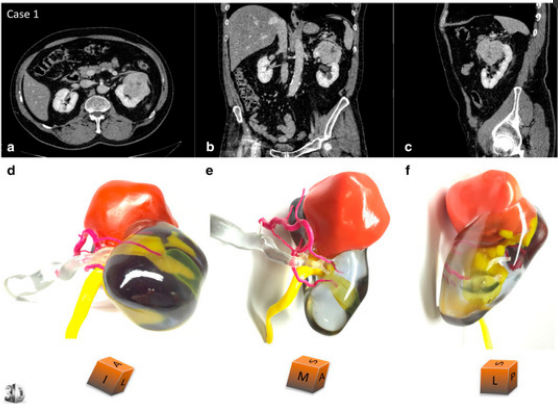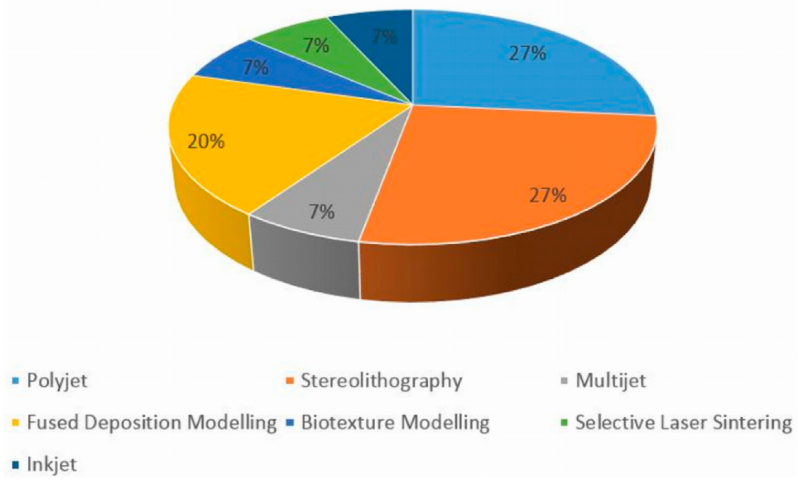Assessing the Effectiveness of 3D Printed Medical Models for Renal Surgeries
Catalina Lupulescu and Zhonghua Sun explore the valuable connection between 3D printing and progressive treatment for kidney patients in the recently published ‘A Systematic Review of the Clinical Value and Applications of Three-Dimensional Printing in Renal Surgery.’ In analyzing various reviews regarding 3D printing for renal disease, the authors focus on the affordability and efficiency of fabricating kidney models for several different levels of use by medical professionals. Twenty-seven patient studies are considered within this research as the models were used to educate doctors, patients, and medical students.
As treatment of kidney tumors is on a trend toward being less invasive for patients, medical professionals are relying more on surgical planning techniques such as 3D printing. The researchers raise the concern, however, that there are inconsistencies regarding 3D printing technology, software, and materials—along with accuracy, affordability, and efficiency in production of such items.
Lupulescu and Sun consider research studies over the last two years, sifting through 676 different articles to find 24 suitable for examination. A total of 27 articles were analyzed and discussed as they also added three others after reviewing citations.
“Of these 27 studies, the number of printed 3D models was less than 20 in 26 studies, while the remaining study involved 200 patients who were randomly allocated to either receive pre-operative planning with imaging alone or a combination of imaging and 3D-printed models,” state the researchers.
“Fifty-two percent of studies utilized participants/cases of patients with renal masses highly indicative of renal cell carcinoma (mostly complex), with one case of a patient with bilateral renal tumors. Nineteen percent of studies utilized participants who were eligible or scheduled for undergoing laparoscopic partial nephrectomy surgery.”

3D-printed model of a 67-year-old male with renal tumor at the upper pole of the left kidney. Comparative views of the CT scan at the nephrographic phase ((a) axial, (b) coronal, and (c) sagittal planes) and corresponding views of the physical model ((d) superior and median view, (e) median and anterior view, and (f) lateral view). An inferior polar cyst is also displayed on this model (translucent yellow). The cubes show the 3D-printed model orientation in space (I = inferior face, A = anterior face, L = lateral side, S = superior face, P = posterior face, M = median side). The patient underwent a left radical nephrectomy for a 65 × 56 × 42 mm clear cell renal cell carcinoma, pT1bN0Mx, Fuhrman grade 3. The arterial tree is presented in opaque magenta, the collecting system in opaque yellow, and opaque orange for tumor display. The renal vein and renal parenchyma are kept translucent to allow the best visualization of the relationships between the renal tumor and surrounding structures. Reprinted with permission from Bernhard et al.
PolyJet 3D printing and stereolithography (SLA) was the most popular techniques used, although seven different types were noted overall—to even include biotexture modeling, with multi-materials and multi-colors used in fabrication. Most researchers were experimenting with plastic/resin bases, but silicone and acrylics were used also.
The final analysis by the authors explains that TangoPlus, an acrylic polymer/photopolymer material, was the ‘most useful’ for accuracy and realism in the models. They also found that silicone-based materials more closely resemble kidney tissue.
Along with Mimics, a range of other software tools were used, to include Analyze12.0 and 3D Slicer. Blender was most commonly used for post-processing work.
“The studies that used the Objet 260 and Connex 500 printers utilized more expensive, branded materials such as PolyJet technology and TangoPlus material, while materials such as photopolymers, polylactides, and thermoplastics were used in studies that utilized other, less expensive printers. It was also found that the studies that utilized more-expensive printing technologies used multi-colored materials, in order to superiorly differentiate diseased from healthy tissue on the model,” stated the authors.
The researchers did uncover numerous limitations in using 3D printing, however, to include the amount of time required for both data segmentation and post-processing. They also reported obstacles as so many different software tools are required for segmentation and post-processing. Most importantly though are the issues with affordability—and Lupulescu and Sun point out that this is the main reason 3D printing is not used more in routine practice—as each model could cost as much as $1,000—and especially with the use of higher quality materials. Lesser materials can be used to lower cost, but that is usually reflected in the quality of the models too. The authors also found issue with some of the evaluations as only 5 of the 27 studies discussed any quantitative assessment.
Overall, Lupulescu and Sun explained that the 3D printed models in general are helpful in their accuracy, along with educating junior surgeons and allowing for training tools for surgeons who may be during performing new and delicate procedures. Patients and families can be more involved and educated in the process also.
“It has been revealed that a range of 3D-printing technologies, printer models, and materials exist, and that no gold standard has been identified, as it is based on user-preference. Despite this, study findings suggest that the utilization of different colors may aid in separating healthy from diseased renal tissue, further benefitting the pre-surgical planning process,” concluded the researchers.
“Further research focusing on these areas and encompassing a larger sample size with in-depth quantitative assessment may be able to strengthen findings reported on the accuracy and feasibility of 3D-printed kidney models for the treatment and education of renal disease. An analysis of the literature has demonstrated that the diagnostic and treatment process of renal disease may be assisted if surgeons are able to carry out a mock surgery using models beforehand.”
3D printed medical models are making life easier for surgeons around the world, as well as patients who are not only able to understand more about their diagnoses and impending procedures but are also able to receive better patient-specific care. Models have been created to help surgeons heal bone fractures, reconstruct eye sockets, monitor ventricular devices, and much more.
Find out more about 3D printing for kidney treatment here. What do you think of this news? Let us know your thoughts! Join the discussion of this and other 3D printing topics at 3DPrintBoard.com.
[Source / Images: ‘A Systematic Review of the Clinical Value and Applications of Three-Dimensional Printing in Renal Surgery’]Subscribe to Our Email Newsletter
Stay up-to-date on all the latest news from the 3D printing industry and receive information and offers from third party vendors.
Print Services
You May Also Like
Will Nano Dimension Be Forced to Buy Desktop Metal? Chancery Court Says “Yes”
For the latest updates (as of March 25, 2025), see the end of this article. Desktop Metal’s future is hanging in the balance. The company, once a major player in...
Automation Alley Lays the Infrastructure for Distributed Manufacturing in Michigan and Beyond
For over 25 years, Automation Alley has been at the forefront of Michigan’s technological evolution, helping to reposition the state from its Rust Belt reputation to a modern hub of...
3D Printing News Briefs & Events Roundup: March 15, 2025
In this weekend’s combined 3D Printing News Briefs and Webinars/Events Roundup, we’re covering news about automotive and construction 3D printing, along with AM Forum, TCT Asia, the Experience Stratasys Tour,...
3D Printing Software Market to Hit $6.78B Revenues by 2033
Additive Manufacturing Research (AMR) has released a new edition of its flagship market study, “AM Software Markets 2025: Analysis, Data and Forecast,” offering deep insights into the 3D printing software...





























